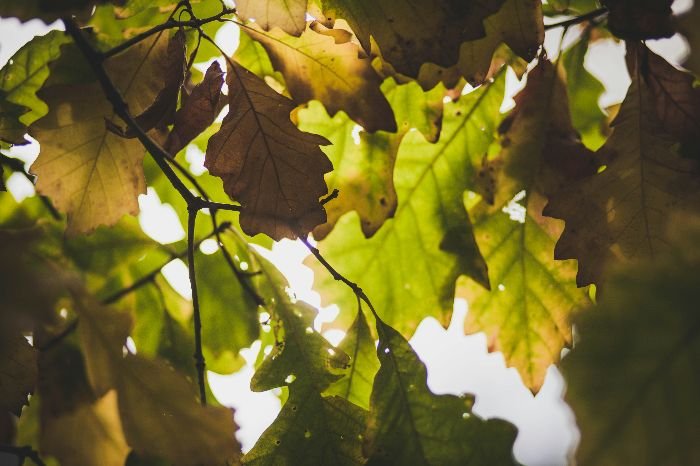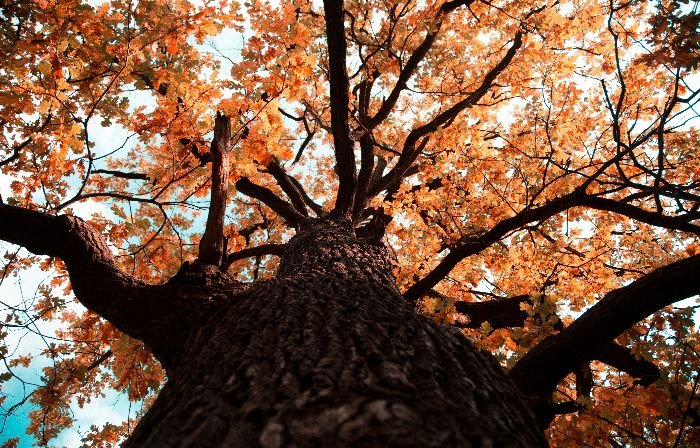Did you know that there are approximately 435 different species of oak trees around the world? These majestic trees, with their diverse range of forms and characteristics, have captured the imaginations of people for centuries. Oak trees are not only beautiful and iconic, but they also play a crucial role in supporting ecosystems and wildlife diversity.
Key Takeaways:
- Oak trees encompass approximately 435 different species worldwide.
- These trees have a rich history and have captivated human culture for centuries.
- Oaks play a vital role in ecosystems, supporting a wide range of organisms.
Table of Contents
The Majestic Oak – A Symbol of Strength and Endurance
The majestic oak tree holds great significance in history and culture, symbolizing strength and endurance. With their towering presence and sturdy trunks, these impressive trees have long been revered for their resilience and stability.
The Historical Significance of Oaks
Oak trees have played a vital role throughout history, valued for their practical uses and symbolic meaning. In ancient times, oak wood was highly prized for its strength and durability, making it a popular choice for building structures that needed to stand the test of time.
In addition to their practical value, oaks have held cultural and historical significance in various civilizations around the world. They have been associated with power, wisdom, and longevity, often being used as symbols of leadership and prestige.
Oaks in Mythology and Culture – A Global Perspective
Across different cultures and mythologies, oak trees have been deeply woven into tales and beliefs, representing profound meanings. Such widespread connections highlight the universal recognition of the oak’s significance.

In Greek mythology, the oak tree was regarded as sacred to Zeus, the king of gods. It was believed to embody his strength and resilience. Norse mythology also revered the oak, associating it with Thor, the god of thunder, and harnessing its protective qualities.
Moreover, oak trees hold cultural importance in many regions. For example, in Celtic culture, they symbolize spiritual growth and connection to ancestors. Native American tribes attribute sacred qualities to oak trees, recognizing their role as providers of food, medicine, and shelter.
The Wide World of Oaks – Exploring Varieties
When it comes to oak trees, the world is a vast and exciting place. With approximately 435 different species, oak trees offer a wide range of variety and diversity. These magnificent trees can be found in various locations across the globe, each with its own unique characteristics.
Distinguishing Between Red Oaks and White Oaks
One way to categorize oak trees is by distinguishing between red oaks and white oaks. While both types belong to the same genus, they have distinct characteristics. Red oaks are known for their sharp, pointed lobes and leaves with bristle-tipped teeth. They typically have acorns that take two seasons to mature. On the other hand, white oaks have rounded lobes and smooth-edged leaves. Their acorns mature in just one season.

It’s important to identify the differences between red oaks and white oaks because they can have different applications, uses, and growth habits. Understanding these distinctions can help in selecting the right oak tree for specific purposes, whether it’s for landscaping, conservation, or woodworking.
Notable Oak Species and Their Unique Traits
Within the wide world of oaks, there are many notable species that stand out for their unique traits. For example, white oaks have the remarkable ability to plug vessels in their wood, preventing the flow of water and air. This feature makes white oak timber highly resistant to decay and a popular choice for outdoor furniture and barrels.
Another interesting aspect of oak trees is the preference of gray squirrels for red oak acorns. These squirrels have been observed to selectively cache and consume the acorns of red oaks. This behavior influences the dispersal and regeneration of red oaks in forests.
Exploring the wide world of oaks reveals a fascinating array of oak varieties, each with its own distinct charms and attributes. Whether it’s the distinguishing features of red oaks and white oaks or the unique traits exhibited by specific oak species, these majestic trees never fail to captivate and intrigue.
Oak Trees Through the Seasons – A Visual Journey
Oak trees are known for their enduring beauty and remarkable transformations throughout the seasons. From the vibrant awakening in spring to the breathtaking color changes of autumn, these magnificent trees take us on a captivating visual journey.
Spring Awakening – New Growth and Flowers
In spring, oak trees come to life with new growth and the emergence of delicate flowers. As the weather warms, buds burst open, revealing fresh, green leaves that add a touch of vibrant color to the landscape. The sight of oak blossoms in full bloom is truly mesmerizing, attracting pollinators and adding a touch of elegance to the surrounding environment.
Autumn Splendor – Color Changes and Acorn Harvest
As the year progresses, oak trees transform once again, showcasing their undeniable splendor during autumn. Leaves transitioning from deep greens to vibrant oranges, reds, and yellows create a breathtaking spectacle of colors that dot the landscape. This natural visual symphony sets the stage for the annual acorn harvest, a crucial event for many wildlife species. The abundant acorns not only provide a source of food but also contribute to the dispersal and propagation of oak tree populations, ensuring their continued existence.

Witnessing the color changes and acorn harvest of oak trees during autumn is an awe-inspiring experience that reminds us of nature’s beauty and the cyclical patterns of life.
Growing Your Own Oak – Care and Considerations
If you have the desire to grow your own oak tree, there are a few important care and consideration factors to keep in mind. From selecting the right oak species to providing proper planting, watering, and maintenance, the success of your oak tree’s growth and longevity depends on these essential guidelines.
Selecting the Right Oak for Your Space
When choosing an oak species, it is crucial to assess the available space in your yard or garden. Oak trees come in various sizes and shapes, ranging from small ornamentals to large shade trees. Consider factors such as the tree’s growth potential, mature height and spread, soil and sunlight requirements, as well as any potential issues with nearby structures or overhead power lines. By selecting an oak species that suits your space, you can ensure a harmonious growth environment for both the tree and your surroundings.
Planting, Watering, and Maintenance Tips
Proper planting techniques are essential to provide a solid foundation for healthy oak tree growth. Ensure that the planting hole is wide and deep enough to accommodate the tree’s root system, and avoid burying the trunk too deeply. After planting, water the tree thoroughly and add a layer of mulch around the base to retain moisture and deter weed growth.
Regular watering is crucial for the establishment and survival of young oak trees. Keep the soil evenly moist, especially during dry spells, and avoid overwatering to prevent root rot or waterlogged conditions. Once the tree is established, watering frequency can be reduced, but it’s important to monitor soil moisture levels and adjust accordingly.
Maintenance tasks for oak trees include regular pruning to remove dead or damaged branches, promote proper structure, and enhance overall tree health. Prune oaks during their dormant period to minimize the risk of disease transmission, and be cautious of oak wilt disease, which can be spread through pruning wounds.
Additionally, keep an eye out for signs of pests or diseases, such as oak leaf blister, oak gall, or oak wilt, and take appropriate measures to manage and prevent their spread. Implementing a regular fertilization schedule can also help provide the necessary nutrients for optimal growth.
Oaks and the Ecosystem – Beyond Beauty and Shade
The Ecological Importance of Oak Trees
Oak trees go far beyond their aesthetic appeal and shade-providing capabilities. They are invaluable contributors to our ecosystems, playing a crucial role in maintaining biodiversity, carbon sequestration, and air quality improvement. Oak trees have a remarkable ability to support and sustain a wide array of plant and animal species, making them vital to the health of our environment.
Oaks as a Habitat – Supporting Wildlife Diversity
In addition to their ecological importance, oak trees serve as habitats that support a diverse range of wildlife species. The large canopies of mature oak trees provide shelter and nesting sites for birds, such as woodpeckers and owls. The acorns produced by oak trees serve as a valuable food source for many animals, including squirrels, deer, and turkeys. These trees also attract a variety of insects, which in turn provide nourishment for birds and other insectivorous creatures.
By creating a favorable habitat for a wide range of wildlife, oak trees contribute to the overall biodiversity and ecological balance of their surroundings. They enhance the resilience and stability of ecosystems by promoting species interactions and facilitating the maintenance of complex food webs.
FAQ
What is the diversity of oak trees?
Oak trees have approximately 435 different species found across the globe.
What role do oak trees play in ecosystems?
Oak trees are keystone species that contribute to the health of the environment, supporting a wide range of organisms and contributing to biodiversity, carbon sequestration, and air quality improvement.
How are oak trees revered in mythology and culture?
Oaks have been deeply intertwined in mythology and folklore across different cultures, symbolizing wisdom, longevity, and power.
Are there any notable oak species with unique traits?
Yes, there are many notable oak species, such as white oaks that can plug vessels in their wood and red oaks that gray squirrels prefer for their acorns.
What should I consider when growing my own oak tree?
You should consider selecting the right oak species that suits your available space, and follow proper planting techniques, watering, and regular maintenance










